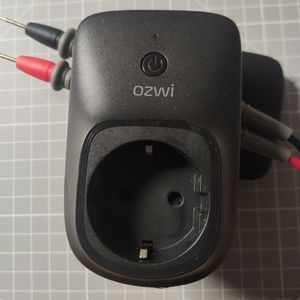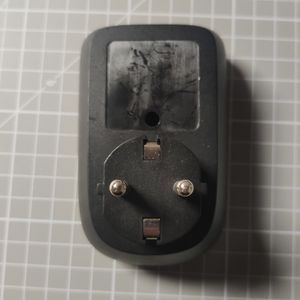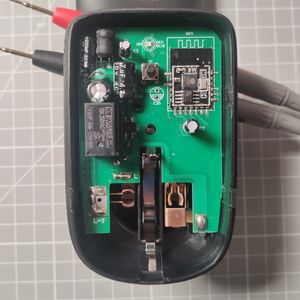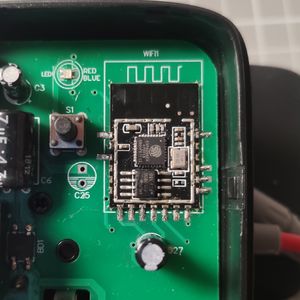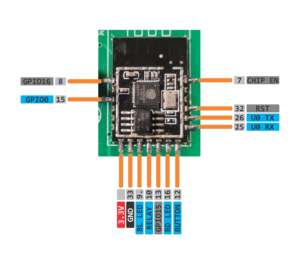Difference between revisions of "OZWI Smart Plug"
Jump to navigation
Jump to search
(Created page with "thumb ==Description== This is a dirt cheap "smart" plug with ESP8266 inside. It's designed for 230V and 10A max current, but other regional versions exist.") |
|||
| (3 intermediate revisions by the same user not shown) | |||
| Line 1: | Line 1: | ||
[[File:OZWIPlug1.jpg|thumb]] | [[File:OZWIPlug1.jpg|thumb]] | ||
| + | [[File:OZWIplug3.jpg|thumb]] | ||
==Description== | ==Description== | ||
This is a dirt cheap "smart" plug with ESP8266 inside. It's designed for 230V and 10A max current, but other regional versions exist. | This is a dirt cheap "smart" plug with ESP8266 inside. It's designed for 230V and 10A max current, but other regional versions exist. | ||
| + | |||
| + | It didn't have any identification or a sticker on it. | ||
| + | ==What's inside== | ||
| + | There's an unknown ESP8266 module, YUANZE Y32F-SS-105HM Relay<ref>[https://www.lcsc.com/product-detail/Power-Relays_YUANZE-RELAY-Y3F-SS-105D_C674561.html LCSC page for the relay]</ref> and power supply components. | ||
| + | |||
| + | [[File:OZWIplug inside1.jpg|frameless]][[File:OZWIplug inside2.jpg|frameless]] | ||
| + | ==ESP8266 Board Pinout== | ||
| + | [[File:OZWIplug pins.png|frameless]] | ||
| + | ==Flashing custom firmware== | ||
| + | You'll need to connect some kind of UART interface device to your PC or other capable device. '''RX''' pin of this device goes to board pin marked "'''U0 TX'''", '''TX''' pin -- to "'''U0 RX'''". '''GND''' to '''GND'''. | ||
| + | |||
| + | Connect '''GND''' and '''3.3V''' pins from diagram above to 3.3V PSU (up to 0.2A was needed during my test). | ||
| + | |||
| + | Connect '''GPIO0''' to '''GND''' and power on the device with PSU. | ||
| + | |||
| + | Flash the chip using [https://github.com/espressif/esptool ESPTool] or other preferred method. | ||
| + | |||
| + | Remove the power and disconnect GPI0 tie to the ground. | ||
| + | |||
| + | Done! | ||
| + | |||
| + | ==Example ESPHome config== | ||
| + | <syntaxhighlight lang="yaml"> | ||
| + | substitutions: | ||
| + | display_name: "ozwi-plug" | ||
| + | friendly_name: "ozwi Smart Plug" | ||
| + | |||
| + | esphome: | ||
| + | name: "ozwi-plug" | ||
| + | |||
| + | esp8266: | ||
| + | board: esp01_1m | ||
| + | |||
| + | # Enable logging | ||
| + | logger: | ||
| + | |||
| + | # Enable Home Assistant API | ||
| + | api: | ||
| + | |||
| + | ota: | ||
| + | |||
| + | wifi: | ||
| + | ssid: !secret wifi_ssid | ||
| + | password: !secret wifi_password | ||
| + | on_connect: | ||
| + | - light.turn_on: blue_led | ||
| + | on_disconnect: | ||
| + | - light.turn_off: blue_led | ||
| + | ap: | ||
| + | ssid: "${display_name} Fallback Hotspot" | ||
| + | password: !secret wifi_AP_password | ||
| + | ap_timeout: 3min | ||
| + | |||
| + | captive_portal: | ||
| + | |||
| + | output: | ||
| + | - platform: gpio | ||
| + | pin: GPIO4 | ||
| + | inverted: False | ||
| + | id: red_led_gpio | ||
| + | - platform: gpio | ||
| + | pin: GPIO14 | ||
| + | inverted: False | ||
| + | id: blue_led_gpio | ||
| + | - platform: gpio | ||
| + | pin: | ||
| + | number: GPIO12 | ||
| + | inverted: false | ||
| + | id: relay1 | ||
| + | |||
| + | binary_sensor: | ||
| + | - platform: gpio | ||
| + | internal: true | ||
| + | pin: | ||
| + | number: GPIO13 | ||
| + | mode: INPUT_PULLUP | ||
| + | inverted: true | ||
| + | name: ${display_name} Switch | ||
| + | on_press: | ||
| + | - switch.toggle: load | ||
| + | |||
| + | light: | ||
| + | - platform: binary | ||
| + | name: "Red LED" | ||
| + | id: red_led | ||
| + | internal: true | ||
| + | output: red_led_gpio | ||
| + | - platform: binary | ||
| + | name: "Blue LED" | ||
| + | id: blue_led | ||
| + | internal: true | ||
| + | output: blue_led_gpio | ||
| + | |||
| + | switch: | ||
| + | - platform: output | ||
| + | name: ${friendly_name} Load | ||
| + | id: load | ||
| + | # internal: true | ||
| + | output: relay1 | ||
| + | on_turn_on: | ||
| + | - light.turn_on: red_led | ||
| + | on_turn_off: | ||
| + | - light.turn_off: red_led | ||
| + | </syntaxhighlight> | ||
Latest revision as of 17:31, 18 December 2023
Contents
Description
This is a dirt cheap "smart" plug with ESP8266 inside. It's designed for 230V and 10A max current, but other regional versions exist.
It didn't have any identification or a sticker on it.
What's inside
There's an unknown ESP8266 module, YUANZE Y32F-SS-105HM Relay[1] and power supply components.
ESP8266 Board Pinout
Flashing custom firmware
You'll need to connect some kind of UART interface device to your PC or other capable device. RX pin of this device goes to board pin marked "U0 TX", TX pin -- to "U0 RX". GND to GND.
Connect GND and 3.3V pins from diagram above to 3.3V PSU (up to 0.2A was needed during my test).
Connect GPIO0 to GND and power on the device with PSU.
Flash the chip using ESPTool or other preferred method.
Remove the power and disconnect GPI0 tie to the ground.
Done!
Example ESPHome config
substitutions:
display_name: "ozwi-plug"
friendly_name: "ozwi Smart Plug"
esphome:
name: "ozwi-plug"
esp8266:
board: esp01_1m
# Enable logging
logger:
# Enable Home Assistant API
api:
ota:
wifi:
ssid: !secret wifi_ssid
password: !secret wifi_password
on_connect:
- light.turn_on: blue_led
on_disconnect:
- light.turn_off: blue_led
ap:
ssid: "${display_name} Fallback Hotspot"
password: !secret wifi_AP_password
ap_timeout: 3min
captive_portal:
output:
- platform: gpio
pin: GPIO4
inverted: False
id: red_led_gpio
- platform: gpio
pin: GPIO14
inverted: False
id: blue_led_gpio
- platform: gpio
pin:
number: GPIO12
inverted: false
id: relay1
binary_sensor:
- platform: gpio
internal: true
pin:
number: GPIO13
mode: INPUT_PULLUP
inverted: true
name: ${display_name} Switch
on_press:
- switch.toggle: load
light:
- platform: binary
name: "Red LED"
id: red_led
internal: true
output: red_led_gpio
- platform: binary
name: "Blue LED"
id: blue_led
internal: true
output: blue_led_gpio
switch:
- platform: output
name: ${friendly_name} Load
id: load
# internal: true
output: relay1
on_turn_on:
- light.turn_on: red_led
on_turn_off:
- light.turn_off: red_led
